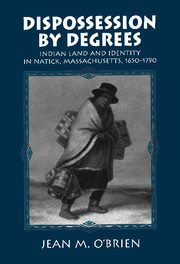Book contents
- Frontmatter
- Contents
- List of illustrations
- Acknowledgments
- Prologue: “My land”: Natick and the narrative of Indian extinction
- 1 Peoples, land, and social order
- 2 The sinews and the flesh: Natick comes together, 1650–75
- 3 “Friend Indians”: Negotiating colonial rules, 1676–1700
- 4 Divided in their desires, 1700–40
- 5 Interlude: the proprietary families
- 6 “They are so frequently shifting their place of residence”: Natick Indians, 1741–90
- Conclusion
- Index
2 - The sinews and the flesh: Natick comes together, 1650–75
Published online by Cambridge University Press: 04 August 2010
- Frontmatter
- Contents
- List of illustrations
- Acknowledgments
- Prologue: “My land”: Natick and the narrative of Indian extinction
- 1 Peoples, land, and social order
- 2 The sinews and the flesh: Natick comes together, 1650–75
- 3 “Friend Indians”: Negotiating colonial rules, 1676–1700
- 4 Divided in their desires, 1700–40
- 5 Interlude: the proprietary families
- 6 “They are so frequently shifting their place of residence”: Natick Indians, 1741–90
- Conclusion
- Index
Summary
Then he said unto me, Son of man, these bones are the whole house
of Israel: behold … Our bones are dried up, our hope is lost…
Therefore prophesy and say unto them …
Behold … I will open your graves, and cause you to come up out of your graves …
And shall put my spirit in you, and ye shall live, and I shall place you in your own land.
Ezekiel 37.11–14Metaphor and place
Between 1650 and 1675, twenty years after the establishment of Massachusetts Bay, Natick came together as a Praying Town. One of John Eliot's favorite texts provided a metaphor for the coming together of Natick, and a point of convergence between the English religion and Native belief. Ezekiel 37 contained a message that gave play to Eliot's millennium-driven preoccupation with the conversion of Israel and his conviction that New England Indians were descended from the Ten Lost Tribes of Israel. The text uses the analogy of bare, dry bones to refer to unconverted Israel; prophesied conversion is given visual content by describing “bone joining bone,” “the sinews and the flesh come upon them,” and the spirit being breathed into them “that they may come to life.”
- Type
- Chapter
- Information
- Dispossession by DegreesIndian Land and Identity in Natick, Massachusetts, 1650–1790, pp. 31 - 64Publisher: Cambridge University PressPrint publication year: 1997



